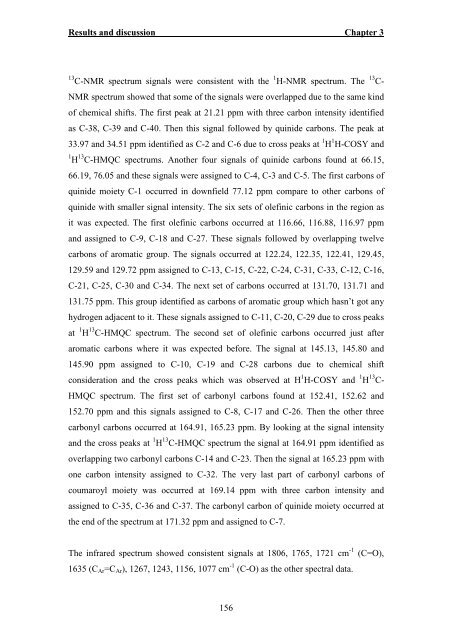Thesis-Final 03 June 2011 pdf - Jacobs University
Thesis-Final 03 June 2011 pdf - Jacobs University
Thesis-Final 03 June 2011 pdf - Jacobs University
You also want an ePaper? Increase the reach of your titles
YUMPU automatically turns print PDFs into web optimized ePapers that Google loves.
Results and discussion Chapter 3<br />
13 C-NMR spectrum signals were consistent with the 1 H-NMR spectrum. The 13 C-<br />
NMR spectrum showed that some of the signals were overlapped due to the same kind<br />
of chemical shifts. The first peak at 21.21 ppm with three carbon intensity identified<br />
as C-38, C-39 and C-40. Then this signal followed by quinide carbons. The peak at<br />
33.97 and 34.51 ppm identified as C-2 and C-6 due to cross peaks at 1 H 1 H-COSY and<br />
1 H 13 C-HMQC spectrums. Another four signals of quinide carbons found at 66.15,<br />
66.19, 76.05 and these signals were assigned to C-4, C-3 and C-5. The first carbons of<br />
quinide moiety C-1 occurred in downfield 77.12 ppm compare to other carbons of<br />
quinide with smaller signal intensity. The six sets of olefinic carbons in the region as<br />
it was expected. The first olefinic carbons occurred at 116.66, 116.88, 116.97 ppm<br />
and assigned to C-9, C-18 and C-27. These signals followed by overlapping twelve<br />
carbons of aromatic group. The signals occurred at 122.24, 122.35, 122.41, 129.45,<br />
129.59 and 129.72 ppm assigned to C-13, C-15, C-22, C-24, C-31, C-33, C-12, C-16,<br />
C-21, C-25, C-30 and C-34. The next set of carbons occurred at 131.70, 131.71 and<br />
131.75 ppm. This group identified as carbons of aromatic group which hasn’t got any<br />
hydrogen adjacent to it. These signals assigned to C-11, C-20, C-29 due to cross peaks<br />
at 1 H 13 C-HMQC spectrum. The second set of olefinic carbons occurred just after<br />
aromatic carbons where it was expected before. The signal at 145.13, 145.80 and<br />
145.90 ppm assigned to C-10, C-19 and C-28 carbons due to chemical shift<br />
consideration and the cross peaks which was observed at H 1 H-COSY and 1 H 13 C-<br />
HMQC spectrum. The first set of carbonyl carbons found at 152.41, 152.62 and<br />
152.70 ppm and this signals assigned to C-8, C-17 and C-26. Then the other three<br />
carbonyl carbons occurred at 164.91, 165.23 ppm. By looking at the signal intensity<br />
and the cross peaks at 1 H 13 C-HMQC spectrum the signal at 164.91 ppm identified as<br />
overlapping two carbonyl carbons C-14 and C-23. Then the signal at 165.23 ppm with<br />
one carbon intensity assigned to C-32. The very last part of carbonyl carbons of<br />
coumaroyl moiety was occurred at 169.14 ppm with three carbon intensity and<br />
assigned to C-35, C-36 and C-37. The carbonyl carbon of quinide moiety occurred at<br />
the end of the spectrum at 171.32 ppm and assigned to C-7.<br />
The infrared spectrum showed consistent signals at 1806, 1765, 1721 cm -1 (C=O),<br />
1635 (C Ar =C Ar ), 1267, 1243, 1156, 1077 cm -1 (C-O) as the other spectral data.<br />
156
















